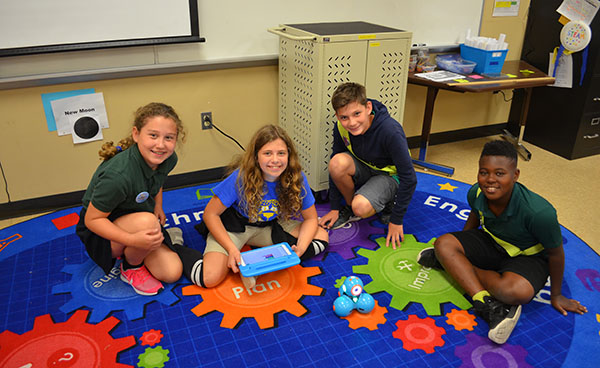
For the past two years, the staff and teachers at H.L. Johnson Elementary School in Royal Palm Beach have been making changes to prepare their students for jobs of the future.
H.L. Johnson implemented a school-wide STEAM program to provide students with a head start in advanced science, technology, engineering, art and mathematics.
Assistant Principal Cyndie Wolf implemented the STEAM program. She believes that children deserve the resources and opportunity to excel in the subjects that will professionally benefit them, 15 years into the future.
“I think it is really important for today’s youth to have a strong background in sciences, technologies and engineering for the jobs that will be available in the future,” Wolf explained. “The jobs that they will have probably don’t even exist yet, so it is important that they know and understand technology.”
Many schools have implemented a STEM program in recent years, providing children with courses in science, technology, engineering and mathematics, but, currently, H.L. Johnson is the district’s only STEAM elementary school in the central region of Palm Beach County, as they incorporate art courses as well.
Students are taught the value and interchangeability of art within the sciences, and they learn that every scientific or technological project has an artistic design.
“The arts and sciences go hand-in-hand,” STEAM resource teacher Suzanne Adams said. “Anything that is designed, like a graphic design, has to be aesthetically pleasing, but also has to [function] technologically.”
The STEAM courses, which are part of all kindergarten through fifth-grade fine arts rotations, are to help students build skill in problem solving, critical thinking, communication and collaboration. Students often work together on projects, on which they learn to share technological and artistic tasks.
“A great coder may not be that artistic, so they have to collaborate with an artistic person who understands the science and engineering behind the project,” Adams said.
The ultimate goal from implementing the STEAM program is to give American students the resources and academic knowledge to excel in all forms of science.
Along with jumping on board with international academic standards, the school aims to encourage more girls to find and develop passion for the STEAM subjects, in order to increase the number of female scientists and engineers in the future.
Jennifer Ward, a fifth-grade gifted science teacher, is excited about the future possibilities.
“I’m finding that after the [beginning of] STEAM classes, children are very excited about science and math,” she said. “Studies have shown that if students get involved with science in the first grade, they will advance, do better and be more interested in science, technology and math all the way through high school. The different STEAM labs just make them even more excited to learn about each subject.”
The STEAM labs at the school are allowing students to gain basic skills in block coding and design. All grades have access to robots that can be controlled by coding on an iPad.
H.L. Johnson has six computer labs, one for every grade level. Additionally, the school has three zSpace 3D virtual reality computers, two 3D printers, an iPad lab, Dash and Dot robots and four laptop carts available to students to gain hands-on experience with newer advanced technology.
“It’s their world; this isn’t necessarily the way we are used to teaching, but we have to meet them at their level and at their future level,” Wolf said. “We have been hurrying to catch up.”
In February, students participated in a school-wide science fair, in which project themes and guidelines were broadened in order to give students the opportunity to do work within whichever branch of science they were most interested.
“This year, the district opened up the science fair to different categories,” Ward said. “The categories weren’t just STEM. They opened themes up to environmental topics, physical science topics, aviation topics or energy topics. So, if a child wanted to take a step forward and combine different topics, they could. This allowed a wide variety of projects to go forward to the district fair.”
Fourteen H.L. Johnson science fair projects, of different subject categories, qualified to go to the district science fair. The qualifying students won first place within each different category and grade level.







